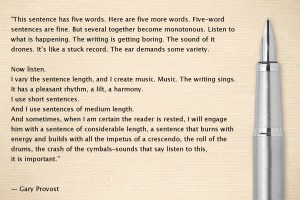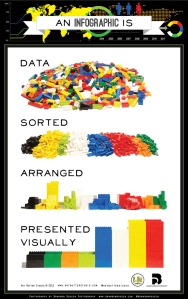Web resource for visual aid design
Often public speaking textbooks give visual aid advice that is overly technical, too simplistic for computer-savvy college students or just hopelessly outdated. I’m always on the search for basic advice that is also practical and will apply to a variety of software programs.
Andrew Dlugan’s “Slide Fonts: 11 Guidelines for Great Design” from the Six Minutes blog gives great advice (though I’m still partial to serif fonts myself) along with picture demonstrations about why the advice works, which you can use for class.
If you need some good material on visual aids, especially slides, this would be a good reading assignment for students or rules to present in class. It could be turned into an activity if followed by several “rule-breaking” examples for discussion.
Web resource for group communication
Speaker and author Keith Ferrin explains two key words that help focus every group interaction (or speech planning) at the Dynamic Communicators blog.
…so that…
By placing the purpose at inform, update, educate, etc., it not only leaves the meeting’s purpose one-sided, but also leaves it unable to be assessed — was the meeting necessary? did it succeed?
Having the answer to “so that…” can give the meeting planners the sharp focus, making better use of everyone’s time.
For a class activity, challenging students to add “so that…” to a specific-purpose writing exercise for a speech or an agenda-writing exercise for a group assignment would be an excellent extension of the activity.
Board games to use for in-class activities
I love board games. Recently I was helping another prof develop some in-class activities and recommended activities based on three board games that I incorporate into class.
- Scattergories: For the most part, it is the alphabet-sided die that comes in useful. For a brainstorming session in looking for topic ideas, I have put students in groups and challenged them to come up with as many ideas as they can within a set time that start with the letter randomly rolled on the die. This can be repeated with 2-3 letters, and the topics can be narrowed if you like (“Things about this campus starting with letter W — go!”). After generating a list — and according to the rules of brainstorming there is no questioning or evaluating list items as the list is created — the students are then asked to choose 1-2 items that can be stretched or expanded into interesting speech topics for class. If you have more time to spend on topic selection, a version more faithful to the rules of the game might be helpful as well.
- Mindtrap: Not all speech textbooks have a reasoning section, but I always dedicate one or two days to covering the basics of reasoning and fallacies as part of the persuasive unit. Mindtrap comes with dozens of cards with logic puzzles and word games of varying difficulty. Not all are straight reasoning, so I have selected out cards that best illustrate the point for class. Students get into groups and are given copies of the cards (because the original cards have answers on the back) and work them together. If they get an answer quickly or need a hint, they can let me know. When they solve it, I will give them another card while the other groups work. One group member is a recorder who is called on during the debriefing to describe the logical process the group took to find the answer, which I can then relate to the types of logic as I discuss them later.
The other prof was doing exercises that focused on creativity and was able to find examples of lateral thinking in the game deck and use the same steps of the exercise.
- The Whole Brain Game: This is a game consisting of two decks — one a list of words associated with various colors (nouns are listed as Green words, for example) and the other deck are questions. The question deck calls on you to use specific random words from the first deck. The questions ask you to look for connections between two random words, or to treat the words as a superpower, or to make the word a human and speak in its voice, among other things. You are given a brief period of time to answer each question and scored by the quantity of acceptable answers you give.
The decks have been great to incorporate into class activities, challenging students to create fresh metaphors, be creative with transitions, and see topics in a new way.
I’ve been able to incorporate these games into activities in public speaking and my colleague had success using them for activities in an advertising class as well.
Are there any board games you have found useful for class activities? I’d love to add them to the list.
Web resource for engaging the audience
Ciara Byrne of Fast Company has compiled several tips from speaker and author Nancy Duarte about helping speakers make technical material more engaging for their audience. While these tips are great for a class full of business or science majors, they would apply equally to any public speaking classroom where students are falling into a pattern of dull speeches.
Some of the tips I found most compelling:
- Avoid PowerPoints full of bullets. Tell a story with a hero — and the hero is not the speaker but the audience.
- The audience is there to hear you speak, not to have the slides speak for you.
- Create contrast. When something changes in your presentation, the audience is re-engaged.
The story also has some good examples to share with a technical-minded audience.
If you have a class of science or business majors, this could be a chance to create an in-class activity (or longer homework assignment) as well. Give students a transcript of a dull grant-request presentation, for example, and have them look for ways to apply some of these suggestions. A failed bid from a “Shark Tank”-type of television show could work.
Web resource about Winston Churchill’s speeches
If you want to bring in some historical speeches to show to students, Winston Churchill would be an excellent choice…inspiring, powerfully worded, and often witty, Churchill’s speeches stand up to the test of time.
The web site The Art of Manliness has provided an eight-part analysis of what made Churchill’s speeches so compelling.
This could be developed into an activity by showing clips of some speeches (the article lists several specific speeches) and then asking students what makes them work. Any part of the article’s list that did not come in during the discussion could then be brought in as a wrap-up.
(I would note, though, that writing out a speech is important when you’re a leader whose speech will be reported and re-read through history and exact wording is important, but writing a speech out is not recommended for more casual settings, especially as most of us lack the acting talent to make it look natural in front of a small audience. It is unlikely his brilliant double glasses trick would work with 15 people in a modern training seminar, for example.)
Example and in-class activity for language
This example appears in several places online and has several available graphics. It is attributed to Gary Provost from his book 100 Ways to Improve Your Writing.
It is a great example for speech students because while the rhythm of words is important in writing, we could argue that it is vital in speech. The variety of sentence length keeps the speech interesting and the audience tuned in — too many short sentences and the speech can feel rushed and unprepared, too many long sentences and the speech can feel written or memorized and out-of-sync with the audience.
This example could be used as a visual aid in class or developed into a demonstration by having students read the various portions of it and comparing their reactions as audience members to hearing the speech in various ways. For a longer activity, wait to show this example and instead have various groups of students write similar examples to compare and then follow up with this example in the debriefing.
Example for visual aids
This simple graphic from Hot Butter Studio is an excellent example of an effective use of visual aids.
I emphasize to students that visual aids should not just repeat what the speaker is saying (although their professors will often use them this way to simplify note-taking). However, most audiences for speeches are not taking notes because they expect to be tested over content, so visual aids should only be used when they can ADD something that the words alone cannot provide.
One effective use of visual aids is to help the audience visualize numbers. Simply listing the numbers will not be as effective as putting those numbers in a meaningful context, as this example illustrates.
In addition to showing the example in class for how and why to show data, it could also be part of a class activity where students analyze a series of visual examples for effectiveness — what does it get right, get wrong, or whatever your textbook gives as standards for good visual aids.
Video for persuasion (counterarguments)
The Simpsons: Season 4, episode 17
This episode features a sequence at a union meeting where Homer and his fellow employees are offered a new deal on their contract that involves giving up their dental plan. Homer brings a stop to the deal because he recently found out that Lisa will need braces. This leads to some follow-up questions:
- Why did Homer want to kill the new deal?
- If Mr. Burns had anticipated that problem and said that the dental plan would remain for two more years, would Homer have reacted the same way?
- If anyone has seen this episode, what happens?
This leads into a discussion of why it is important to also research the other side of the argument and be prepared to address their objections.
This is often cited as one of the best Simpson episodes — and deserves it. It is rich in terms of persuasive techniques attempted at various points in the impasse.
Video for reasoning
The Simpsons: Season 3, episode 4
Video available at SimpsonsWorld;
Link to episode description
In this video, reputed mobster Fat Tony Williams defends his questionable actions to Bart. Bart has taken a job with Fat Tony and had been asked to store a large quantity of cigarettes at his house. Bart later finds out that a truck of cigarettes has been stolen and asks Fat Tony about it.
This clip shows two types of reasoning — deductive and analogical — and at least three logical fallacies. The students can be asked to identify these. This videoclip is currently available for free at SimpsonsWorld.com.
Visual aid for delivery
The blog at Prezi.com took advice about how to deal with delivery problems from Terry Gault of The Henderson Group and created this memorable visual aid.
Using the anagram ABSORB, it gives simple and easy to remember advice for what to do if the worst happens during a presentation.
The visual would be a good addition to class, along with a discussion allowing the students to share additional advice or stories of what they have seen done well or badly.




